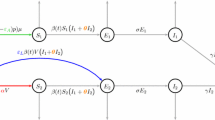Abstract
Many diseases, such as the seasonal flu, tetanus, and smallpox, can be vaccinated against with a single dose of a vaccine. However, some diseases require multiple doses of a vaccine for immunity. For example, Hepatitis B requires three doses of a vaccine, with the second occurring about 1 month after the first and the third occurring about 5 months after the second, for immunity. Diseases requiring a multistage vaccine such as Hepatitis B can have extra complications with its vaccination program, as some who start the doses may forget to complete the program or could become infected before completing the program. This article concerns the setup and analysis of a model for disease spread with a multistage vaccine available to investigate how effective such a vaccine would be at establishing herd immunity for the disease as well as establishing the short-term and long-term effects of such a vaccine.



Similar content being viewed by others
References
Brauer F, Castillo-Chavez C (2010) Mathematical models in population biology and epidemiology. Springer, New York, pp, 275–302
Centers for Disease Control and Prevention (2009) 2009 H1N1 Influenza vaccine—dose spacing for children 6 months through 9 years of Age. http://www.cdc.gov/h1n1flu/vaccination/dosespacing.html. Accessed 7 Aug 2014
Centers for Disease Control and Prevention (2012) Vaccine information statements—Hepatitis B. http://www.cdc.gov/vaccines/hcp/vis/vis-statements/hep-b.html. Accessed 7 Aug 2014
Dawood F et al (2012) Estimated global mortality associated with the first 12 months of 2009 pandemic influenza a H1N1 virus circulation: a modelling study. Lancet Infect Dis 12(9):687–695
Hoyert DL, Xu J (2012) Deaths: preliminary data for 2011. Natl Vital Stat Rep 61(6). http://www.cdc.gov/nchs/data/nvsr/nvsr61/nvsr61_06. Accessed 28 May 2014
Kelley D, Peterson A (2004) The theory of differential equations: classical and qualitative. Pearson Education, Upper Saddle River, pp 107–114
Kermack WO, McKendrick AG (1927) A contribution to the mathematical theory of epidemics. In: Proceedings of the Royal Society of London. Series A, containing papers of a mathematical and physical character, vol 115, No. 172, pp 700–721
Korobeinikov A (2009) Global properties of SIR and SEIR epidemic models with multiple parallel infectious stages. Bull Math Biol 71:75–83
Martin JA et al (2013) Births: final data for 2012. Natl Vital Stat Rep 62(9). http://www.cdc.gov/nchs/data/nvsr/nvsr62/nvsr62_09. Accessed 28 May 2014
Acknowledgments
This work would not have been possible without the generous support of Benedictine University and its College of Science Summer Research Program, directed by Dr. Lee Ann Smith and College Dean Bart Ng, who funded the students’ work on this project, as well as the Benedictine University Faculty Development Committee, who funded the faculty member’s work on this project.
Author information
Authors and Affiliations
Corresponding author
Rights and permissions
About this article
Cite this article
DeLegge, A., Hunzinger, K., Khatri, R. et al. An Epidemic Model With a Multistage Vaccine. Bull Math Biol 77, 499–513 (2015). https://doi.org/10.1007/s11538-015-0069-5
Received:
Accepted:
Published:
Issue Date:
DOI: https://doi.org/10.1007/s11538-015-0069-5




